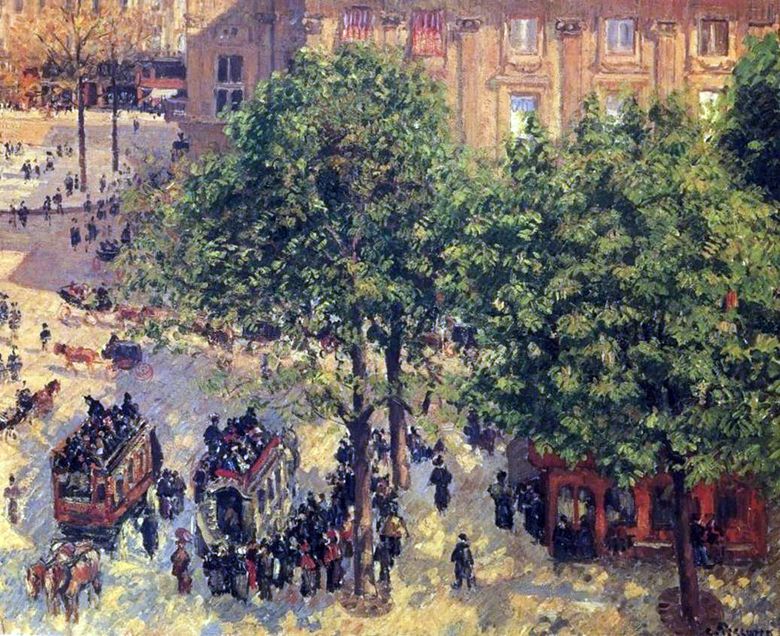
The theme of the big city occupied a modest place in the painting of the XIX century. We can say that the Impressionists were the first to introduce the urban landscape into French art. Especially great in this merit K. Pissarro, comrade and ally Monet. In the 1890s, already in old age, but fully armed with talent and brilliant craftsmanship, he created many canvases with views of Paris.
The Square of the French Theater differs from other similar Pissarro paintings in that it features a feature characteristic of the artist’s work: an introduction to the landscape of elements of the everyday genre. Depicting a favorite corner of the city, Pissarro does not think it without people in their daily lives.
A small area, which the artist sees from the workshop window, is filled with dozens of Parisians: they stand in a queue for an omnibus, walk down the street or ride in carriages, talk in the shadow of thick chestnuts. Totally delineated figures, completely disappearing when trying to look at them closely, give the canvas a special liveliness, convey the fussiness of a small corner of a large city.
In the film “The Square of the French Theater”, the reasonableness of this seemingly unbuilt composition is striking. This is where the inherent Pissarro architectonicity of the compositional solution appears. The picture is vertically and horizontally divided into equal parts. Thin-round circular tree-kaps fit into the canvas quadrangle, giving the composition clarity and stable balance. The space in the Pissarro picture is underlined by the texture of the paint layer: the foliage of chestnuts in the foreground, written densely, densely, “corporeally”, almost illusory, emphasizes the subtle, transparent background painting.
Color contributes to the overall cheerfulness, cheerful mood of the picture. The cityscape of Pissarro is penetrated by sunlight. The pale yellow and cream tones of the walls of the buildings and the pavement, illuminated by the sun, the gray-blue transparent shadows, the lush green of the trees, the red spots of the striped “marquis” on the windows – all merge into a single major colorful chord.
The picture entered the Hermitage in 1930 from the State Museum of New Western Art in Moscow.
 Opera travel in Paris. The effect of snow. Morning by Camille Pissarro
Opera travel in Paris. The effect of snow. Morning by Camille Pissarro Place du Théâtre Français à Paris – Camille Pissarro
Place du Théâtre Français à Paris – Camille Pissarro Lacroix Island Rouen by Camille Pissarro
Lacroix Island Rouen by Camille Pissarro Self Portrait by Camille Pissarro
Self Portrait by Camille Pissarro Spring in Pontoise by Camille Pissarro
Spring in Pontoise by Camille Pissarro View from my window by Camille Pissarro
View from my window by Camille Pissarro Red Roofs by Camille Pissarro
Red Roofs by Camille Pissarro Church of St. Jacques. Dieppe by Camille Pissarro
Church of St. Jacques. Dieppe by Camille Pissarro